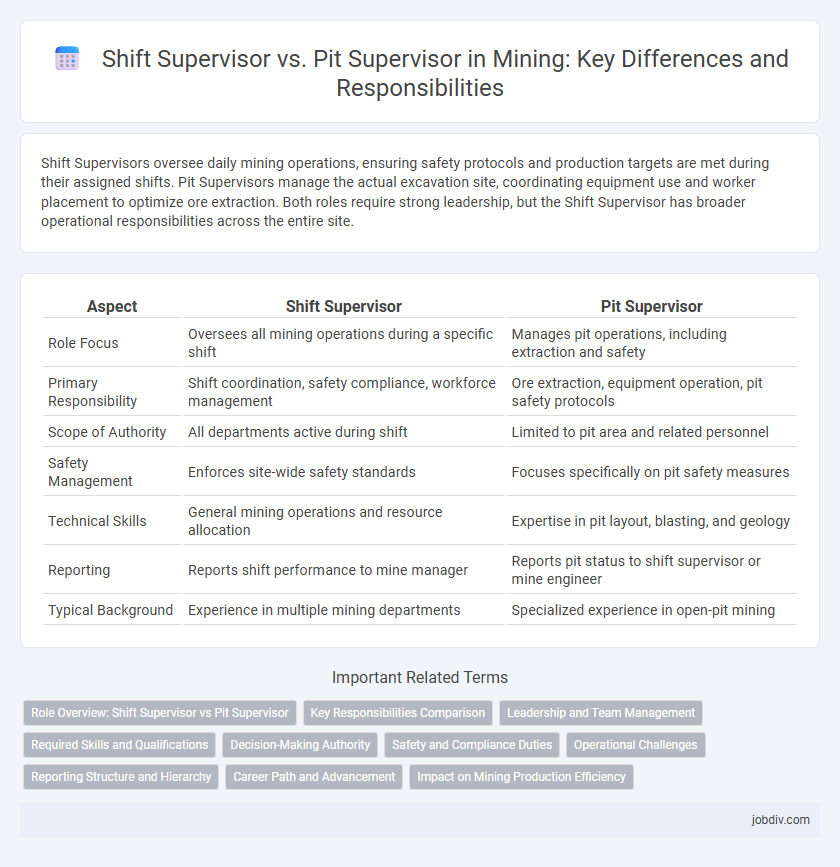Shift Supervisors oversee daily mining operations, ensuring safety protocols and production targets are met during their assigned shifts. Pit Supervisors manage the actual excavation site, coordinating equipment use and worker placement to optimize ore extraction. Both roles require strong leadership, but the Shift Supervisor has broader operational responsibilities across the entire site.
Table of Comparison
| Aspect | Shift Supervisor | Pit Supervisor |
|---|---|---|
| Role Focus | Oversees all mining operations during a specific shift | Manages pit operations, including extraction and safety |
| Primary Responsibility | Shift coordination, safety compliance, workforce management | Ore extraction, equipment operation, pit safety protocols |
| Scope of Authority | All departments active during shift | Limited to pit area and related personnel |
| Safety Management | Enforces site-wide safety standards | Focuses specifically on pit safety measures |
| Technical Skills | General mining operations and resource allocation | Expertise in pit layout, blasting, and geology |
| Reporting | Reports shift performance to mine manager | Reports pit status to shift supervisor or mine engineer |
| Typical Background | Experience in multiple mining departments | Specialized experience in open-pit mining |
Role Overview: Shift Supervisor vs Pit Supervisor
A Shift Supervisor oversees the overall operations and workforce productivity during a specific shift, ensuring safety compliance and efficient task execution across various mining activities. A Pit Supervisor specializes in managing the day-to-day functions within the mining pit, focusing on excavation, drilling, blasting, and maintaining equipment performance. Both roles require leadership, but the Shift Supervisor has a broader scope across shifts, while the Pit Supervisor concentrates on in-pit operational control.
Key Responsibilities Comparison
Shift Supervisors oversee the overall operations and safety compliance during their assigned shifts, coordinating personnel and managing equipment to ensure continuous production. Pit Supervisors specifically manage activities within the mining pit, including overseeing drilling, blasting, and material extraction processes while ensuring adherence to operational plans and safety standards. Both roles demand strong leadership and communication skills, with Shift Supervisors focusing on broad operational control and Pit Supervisors concentrating on tactical pit-level execution.
Leadership and Team Management
Shift Supervisors in mining oversee operational efficiency and safety during specific shifts, ensuring compliance with protocols and coordinating real-time problem-solving among team members. Pit Supervisors hold broader responsibilities, including strategic planning of mine pit activities, resource allocation, and managing larger teams to optimize production and maintain safety standards. Leadership for Shift Supervisors centers on immediate decision-making and direct team management, while Pit Supervisors focus on long-term leadership, workforce coordination, and cross-department collaboration within the mining site.
Required Skills and Qualifications
Shift Supervisors in mining typically require strong leadership skills, safety management certifications, and the ability to coordinate diverse teams during operational shifts. Pit Supervisors need extensive knowledge of excavation techniques, geological assessment, and compliance with environmental regulations, along with qualifications in mining engineering or related fields. Both roles demand excellent problem-solving abilities, communication skills, and experience with site-specific safety protocols.
Decision-Making Authority
Shift Supervisors in mining oversee daily operational decisions on the site, managing workforce coordination and immediate safety protocols, whereas Pit Supervisors hold greater decision-making authority related to overall mining strategy, resource allocation, and production targets within the pit area. Pit Supervisors are responsible for critical decisions affecting extraction processes, equipment deployment, and compliance with environmental regulations, reflecting a broader scope of authority compared to Shift Supervisors. The distinction in authority directly impacts operational efficiency and safety management, with Pit Supervisors typically influencing long-term planning and Shift Supervisors focusing on real-time execution.
Safety and Compliance Duties
Shift Supervisors in mining oversee overall operations, ensuring that safety protocols and regulatory compliance are rigorously followed throughout their shifts. Pit Supervisors focus specifically on pit operations, monitoring ground stability, equipment safety, and adherence to environmental regulations within the excavation site. Both roles require thorough knowledge of mining safety standards, but Shift Supervisors have broader responsibilities across multiple site activities, while Pit Supervisors concentrate on direct pit safety and operational compliance.
Operational Challenges
Shift Supervisors primarily manage workforce coordination and safety compliance during mining operations, ensuring real-time problem-solving on equipment malfunctions and workflow disruptions. Pit Supervisors face operational challenges involving pit stability, ore extraction efficiency, and environmental hazard mitigation, requiring constant monitoring of geological conditions and adherence to mining plans. Both roles demand rapid decision-making under pressure but differ in focus areas: workforce and immediate operational control for Shift Supervisors versus strategic pit management and safety oversight for Pit Supervisors.
Reporting Structure and Hierarchy
Shift Supervisors typically report directly to the Pit Supervisor and oversee daily operations on-site, ensuring smooth workflow and immediate problem resolution. Pit Supervisors hold a higher hierarchical position, managing multiple shifts and coordinating with upper management on production targets, safety compliance, and resource allocation. The reporting structure establishes the Pit Supervisor as the primary authority responsible for strategic decisions and overall pit performance.
Career Path and Advancement
Shift Supervisors typically manage daily operations and coordinate frontline teams, serving as a critical link between mine workers and management. Pit Supervisors have broader responsibilities, overseeing entire pit operations, including safety compliance, production targets, and resource allocation, which positions them for higher managerial roles. Career advancement from Shift Supervisor to Pit Supervisor often requires enhanced technical knowledge, leadership skills, and experience in pit management, making the transition a key step toward senior mine management and executive roles.
Impact on Mining Production Efficiency
Shift supervisors oversee overall mining operations, ensuring adherence to safety protocols and coordinating workforce activities to maintain continuous production flow. Pit supervisors concentrate on managing the extraction process within the mining pit, optimizing equipment utilization and minimizing downtime to directly boost ore recovery rates. Effective collaboration between both roles enhances mining production efficiency by streamlining operational processes and reducing bottlenecks on-site.
Shift Supervisor vs Pit Supervisor Infographic

 jobdiv.com
jobdiv.com